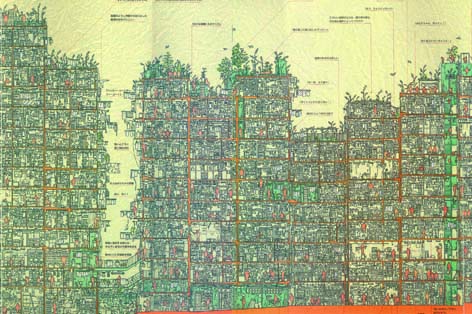The walled city
This essay is in many ways a companion piece to Gary Hall’s ‘Pirate Radical Philosophy’ in RP 173 (May/June 2012). Consider it a prequel, or something akin to a video game’s expansion pack, extending and elaborating on the original’s materials. It is a story of the spatial history of escape routes, secret countries, renegade zones and lines of flight and circulation, and so it begins with an other-worldly, fairytale conceit: our scientist narrator, Gustave Affuelpin, has created a ‘contractive beam’, a matter-reduction ray.1
 In a single August night in 1975, he silently excavates several million cubic metres of earth below the space demarcated for the construction of the Centre Beaubourg. The architects are pleased to save on the budget set aside for digging the foundation, and a concrete slab is laid to ‘divide the two cultural universes’. While the Beaubourg’s massive Meccano set comes together above, eighty storeys of bare concrete slabs, empty stairwells and the most minimal infrastructure for ‘the circulation systems for people and fluids’ are installed below. It is the anti-museum, the anti-‘cultural centre’: one beaubourg among others rather than the Centre Beaubourg, an underground building that can’t be admired, a brutalist blank of empty rooms meant for creation rather than representation, a factory rather than a vitrine. The creator provides only space, illumination twenty-four hours a day, and ‘an excessive amount of chalk’. Everything else is up to the participants. Installation art, scavenged furniture, enormous paintings, motorcycle rallies, electro-acoustic workshops, gift economies, sexual licence and many interminable political meetings ensue.2
In a single August night in 1975, he silently excavates several million cubic metres of earth below the space demarcated for the construction of the Centre Beaubourg. The architects are pleased to save on the budget set aside for digging the foundation, and a concrete slab is laid to ‘divide the two cultural universes’. While the Beaubourg’s massive Meccano set comes together above, eighty storeys of bare concrete slabs, empty stairwells and the most minimal infrastructure for ‘the circulation systems for people and fluids’ are installed below. It is the anti-museum, the anti-‘cultural centre’: one beaubourg among others rather than the Centre Beaubourg, an underground building that can’t be admired, a brutalist blank of empty rooms meant for creation rather than representation, a factory rather than a vitrine. The creator provides only space, illumination twenty-four hours a day, and ‘an excessive amount of chalk’. Everything else is up to the participants. Installation art, scavenged furniture, enormous paintings, motorcycle rallies, electro-acoustic workshops, gift economies, sexual licence and many interminable political meetings ensue.2
This is no private pocket universe, however – not a remote Shangri-La or an autarchic libertarian space capsule. In the heart of Paris, the subterranean beaubourg is debated in Le Figaro and Le Monde, denounced in Communist Party communiqués, and becomes the lodestar of a complex post-’68 constellation of places like the Sorbonne, the Renault factory and the Coca-Cola bottling plant. (The police never show up in any significant numbers to shut down this catastrophic violation of health and safety codes in which thousands of sans-papiers, dissidents, radicals, recovering addicts, petty thieves and runaways all live full-time. Perhaps the contractive beam keeps them at bay. It is, in any case, not a blueprint but a fairy tale, so let it be.) The walk-on roles for existing people are numerous. Hans-Jürgen Syberberg shows up to make a movie with the painters on the 24th floor. Godard takes up permanent residence and the Bread and Puppet Theatre stage actions. Pontus Hultén – who was, in fact, first director of the Centre Beaubourg, though not a Norwegian as this novel asserts – is a sweating wreck, finally leaving his official position to ‘live culture instead of angling for it in the cemetery of a museum’.3
In their inverted skyscraper all is subject to question and experiment, like the Moscow Walter Benjamin documented in the winter of 1926–27. ‘Each thought, each day, each life lies here as on a laboratory table’, he wrote, with streetcar stops and home furnishings moving about with equal alacrity, buildings repurposed, new ceremonies invented and discarded. In a letter to Jula Radt, he put it most concisely: ‘Everything is being built or rebuilt and every moment poses very critical questions.’4 How are the beaubourgians to sleep? Should there be quiet levels, enclosed spaces, private blankets? How are the electricity and communal baking of nutritious loaves of ‘alicom’ to be paid for – do they need money, or some system of resource allocation? What about consistent identities? And, above all, do they need governance and a political orientation to the world above ground?
[…]
Notes
1. Albert Meister and Luca Turin, The So-called Utopia of the Centre Beaubourg: An Interpretation, Book Works, London, 2007, p. 11.
2. Ibid., pp. 16–17.
3. In keeping with its rejection of all conventional norms, The So-called Utopia abandons numbering the pages after 122. The passage I quote here can be found towards the end of the book, on the page spread marked ‘Cold’ and ‘Allarme!’
⤓ Click here to download the PDF of this item